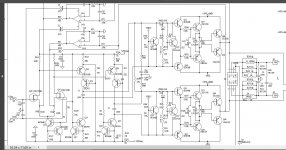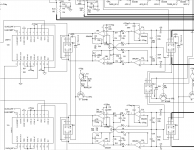Hey guys, I have this amplifier, about 10 minutes after power on I get some really noisy static in one channel.
Which is more likely the culprit, DC offset or bad capacitor?
Which is more likely the culprit, DC offset or bad capacitor?
I would say neither tbh.
Noisy static could be a dry joint or a failing semiconductor, typically the hot running VAS stage or less likely, the input differential pair... as well as a dozen other different things of course.
DC offset by its nature is silent, it is simply a static unwanted DC voltage.
Noisy static could be a dry joint or a failing semiconductor, typically the hot running VAS stage or less likely, the input differential pair... as well as a dozen other different things of course.
DC offset by its nature is silent, it is simply a static unwanted DC voltage.
Thanks, Mooly. Do you think this is something that can be serviced? I already spoke to a technician to come and look at it, but only tomorrow. The amplifier is quite an expensive one and I would hate to part with it.
Any danger for the speakers to run it like this until tomorrow?
Any danger for the speakers to run it like this until tomorrow?
The underlying mechanism is thermal expansion, coupled with a defective component or trace which is sensitive to mechanical strain.
You can track this sort of thing down with a cold-spray, usually - wait till it crackles and spray things until you hit the component involved, at which point it cools and goes silent (with luck).
Alternatively poking with a stick (electrically insulating stick, that is) may directly affect the bad joint/component/pcb.
You can track this sort of thing down with a cold-spray, usually - wait till it crackles and spray things until you hit the component involved, at which point it cools and goes silent (with luck).
Alternatively poking with a stick (electrically insulating stick, that is) may directly affect the bad joint/component/pcb.
Thanks, Mooly. Do you think this is something that can be serviced? I already spoke to a technician to come and look at it, but only tomorrow. The amplifier is quite an expensive one and I would hate to part with it.
Any danger for the speakers to run it like this until tomorrow?
Its certainly fixable but whether it is 'safe' for the speakers is an unknown because it could suddenly develop into something that puts a high DC voltage across the speaker.
Mark's suggestions are spot on and are the two things I would do first.
1/ Give the PCB and components a good tap around with an insulated implement.
2/ Give the board a thorough visual inspection for dries. Look for parts that run hot and check the soldering.
3/ Sparingly use freezer spray. You can use the cheap air duster cans (which are butane based) if you invert them. Practice dispensing the stuff a drip at a time. If you blast a whole area then you have no idea what part you actually sprayed.
So the amplitude of the noise is dependent on volume setting?I forgot to mention that it is volume dependent, dont know if it matters or not...
That's a valuable clue, as it locates the source ahead of the volume control and excludes everything following it - including a lot of the preamp section and the entire power amp.
Indeed,
What is "this amplifier"?
is the question of the day. I know more than a few where there is little more between the inputs and the volume control than the input selector switch. It probably is not one of those.
So the amplitude of the noise is dependent on volume setting?
That's a valuable clue, as it locates the source ahead of the volume control and excludes everything following it - including a lot of the preamp section and the entire power amp.
.
Yes, I dont hear it at low volume.
Should I take this as a good sign, then? Like, it is not something that cannot be fixed?
Last edited:
There is a service manual over at HiFi Engine:
Primare A30 - Manual - Stereo Integrated Amplifier - HiFi Engine
And its not what I was expecting. It looks to be a bridged amp using balanced circuitry.
Fault finding is not going to be easy on something like this and I would say that you really need a scope to look at whether the distortion is appearing on one or both sides of the bridge and also to look at whether the inputs to the power amp are clean.
Primare A30 - Manual - Stereo Integrated Amplifier - HiFi Engine
And its not what I was expecting. It looks to be a bridged amp using balanced circuitry.
Fault finding is not going to be easy on something like this and I would say that you really need a scope to look at whether the distortion is appearing on one or both sides of the bridge and also to look at whether the inputs to the power amp are clean.
Attachments
The interesting part is on the next page. We have already established that the offending noise varies with volume setting, so is likely to be ahead of the respective channel's LM1972. Could be a bad solder joint on one of the relays or one of the passives in the balanced receiver circuit (like one of the various 10ks), or maybe a bad opamp there.
A seasoned tech with a sharp eye may have a better chance of tracking this down, though bad solder joints can be really sneaky at times. Since there are two of every kind of circuit (plus the other channel), some comparative resistance measurements may help.
A seasoned tech with a sharp eye may have a better chance of tracking this down, though bad solder joints can be really sneaky at times. Since there are two of every kind of circuit (plus the other channel), some comparative resistance measurements may help.
Attachments
- Home
- Amplifiers
- Solid State
- DC offset or bad capacitor?

